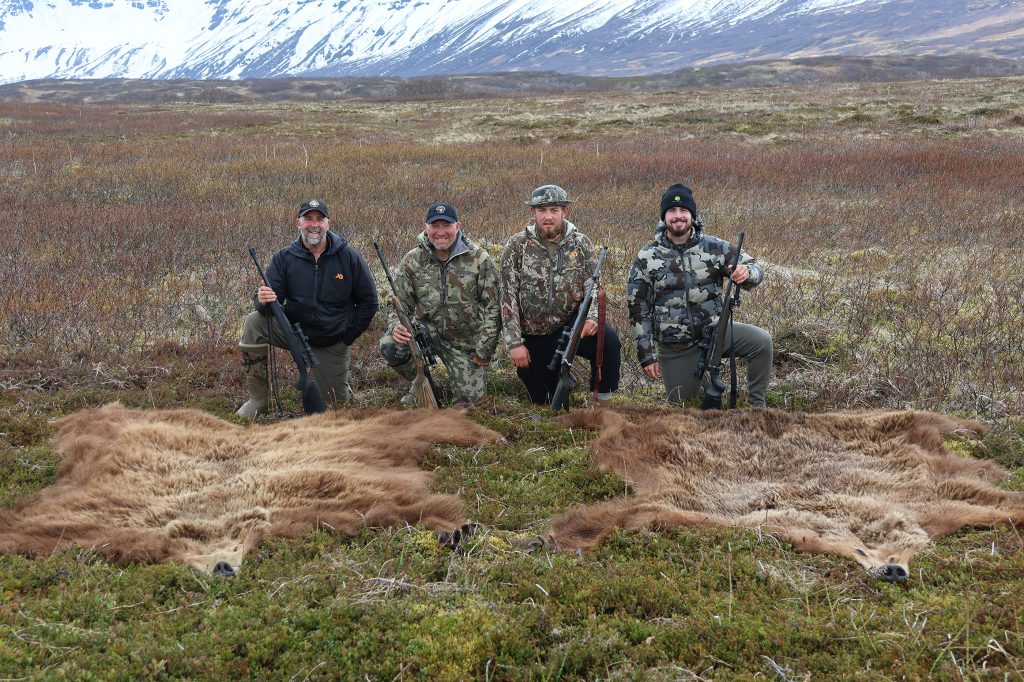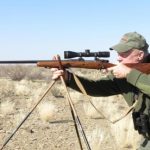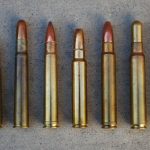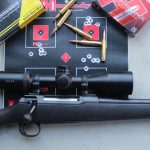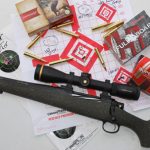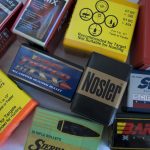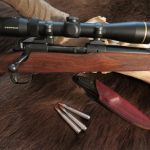It’s the world’s most versatile big-game cartridge.
Photo above: Nobody talks a lot about .375 accuracy because the caliber is typically used for larger animals, and because recoil makes tight groups difficult. But accuracy is usually excellent, as this .375 RUM shows with several different loads.
For worldwide use on game of all sizes, it’s hard to imagine a complete rifle battery that lacks a .375. To be fair, we could lump the .375 with its European equivalent, the 9.3mm (.366-inch). There’s not enough difference in bullet diameter or weight to make serious arguments. However, in the English-speaking world, the .375 is dominant. The 9.3mm, despite its merits, is little known.
Legend has it that Holland & Holland introduced the .400/.375 Belted Nitro Express in 1905 as the answer to the 9.5x57mm Mannlicher. That’s unlikely, because the 9.5 didn’t come out until 1908. The excellent 9.3x62mm Mauser, designed by Otto Beck, also came out in 1905. It took off, and it remains the most popular 9.3mm cartridge. The .400/.375 was the world’s first belted cartridge. Underpowered, it didn’t catch on. H&H apparently believed in the .375-inch bullet. So in 1912 they tried again with the .375 H&H Magnum: same diameter, larger case. The belt was retained as a headspacing index, which was essential with the new cartridge’s tapered case and minimal shoulder.
Although the magnum suffix connotes “larger and more powerful,” it wasn’t applied strictly for sales hype. “Magnum” comes from the French term for an extra-large bottle of champagne. In the staid British gun trade, magnum was only applied to a more powerful cartridge using a bullet diameter previous to that firm. So, rival firm John Rigby’s .350 Rigby Rimless Magnum, following the .400/.350, was termed magnum. The .416 Rigby was not, because it was the first .416-caliber cartridge. Since it followed the failed .400/.375, the .375 H&H was a magnum by all definitions.
To this day, the .375 H&H is one of the world’s most versatile cartridges. It is fast enough and flat-shooting enough for use in plains and mountains, and powerful enough for the world’s largest game. Sure, it has more power than is needed for most game, but it gets the job done. I always argue that the .375 is marginal for elephant, hippo, and rhino. However, it’s on the correct side of the margin, and gets those jobs done as well. Also, it is “street-legal” for the largest game.
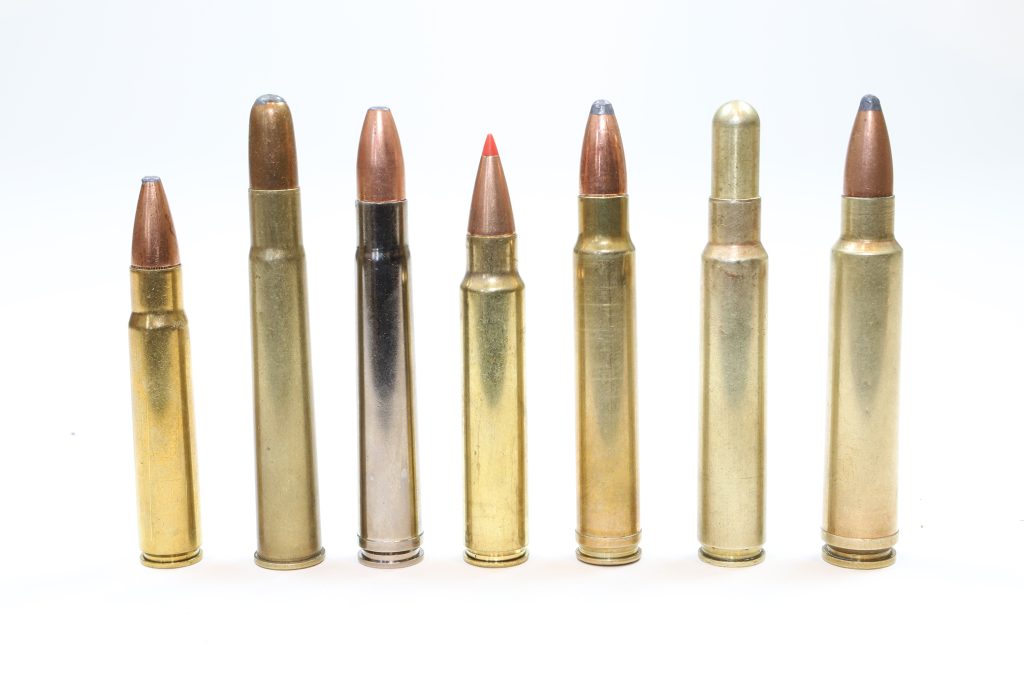
Despite its versatility, the .375 is perfect for just a few species. Lion, eland, and the biggest bears come immediately to mind. I almost included buffalo, but held back. The .375 is just fine for big bovines. However, the “lower .40” cartridges are probably more ideal for Cape and water buffalo.
So, which .375-caliber cartridge should you choose? Initially, there were just two: the .375 H&H Magnum and its rimmed counterpart, the .375 Flanged Magnum. The original belted magnum loads were: 235-grain bullet at 2,800 fps; 270-grain bullet at 2,650 fps; 300-grain bullet at 2,500 fps. The rimmed or “flanged” version was downloaded slightly to reduce pressure in doubles–likely not enough for any buffalo to notice. Some new doubles are so chambered, but the .375 Flanged is mostly seen in older rifles.
The 235-grain load has gone by the wayside, and current .375 H&H loads are faster. Standard velocities today: 2,530 fps for the 300-grain load; 2,690 fps for the 270-grain load. Trajectory of the latter load is about the same as 180 grains in the .30-06. Careful handloading and/or modern loads (such as Hornady’s Superformance) can increase .375 H&H velocity by 100 fps or so. Again, no buffalo is likely to notice.
Yielding something over 4,000 ft-lbs, performance of the .375 H&H on large game remains a gold standard. That said, with increased case capacity .375 bullets can be pushed faster, flattening trajectory and increasing energy yield. The simplest way is to ream out the .375 H&H chamber, removing body taper. In the 1950s, my uncle Art Popham took all his dangerous game with a .375 Improved. Developed in 1944, Roy Weatherby’s .375 Weatherby Magnum is the most common version. The .375 Weatherby Magnum increases velocity by as much as 250 fps, increasing energy yield to more than 5,000 ft-lbs, much the same as the .416 Rigby and .416 Remington Magnum.
In 1953 Weatherby one-upped himself with the .378 Weatherby Magnum, sort of a belted version of the .416 Rigby case. Velocity is sizzling, pushing a 300-grain bullet to 2,900, a .270-grain bullet well over 3,000, with energy yield up to 6,000 ft-lbs. Remington’s .375 RUM was introduced in 2000. In case capacity, the RUM lies between the .375 and .378 Weatherby Magnums. So it’s fast and flat, developing well over 5,000 ft-lbs. The two Weatherby cartridges and the RUM are the only “fast .375” factory cartridges, but there are numerous fast and faster wildcats and proprietaries.
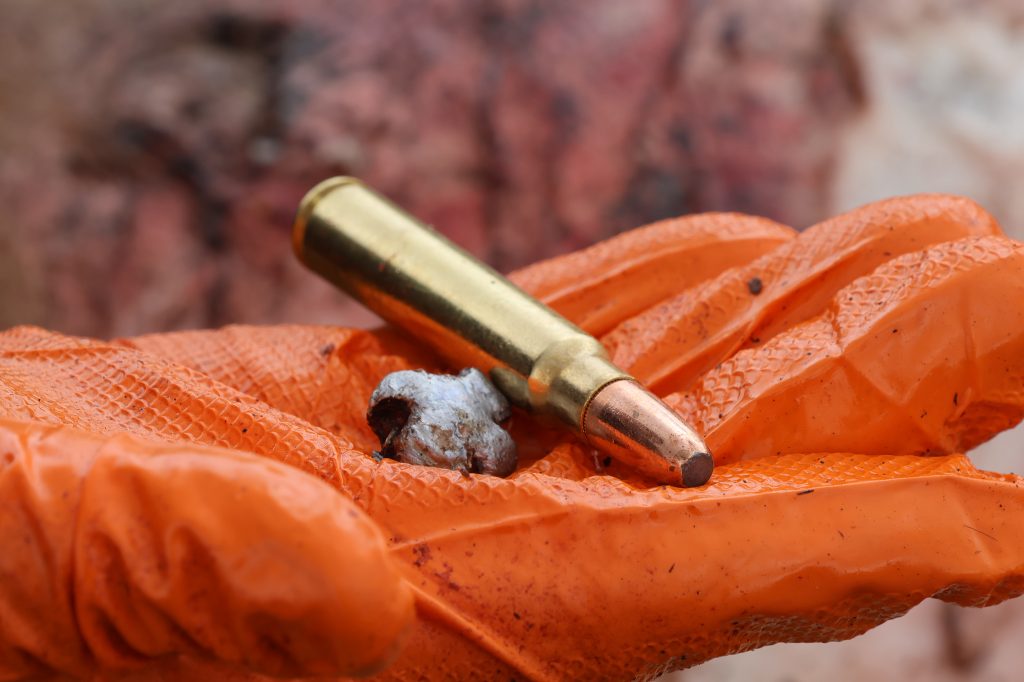
If a little .375 velocity is good, a lot must be better, right? To a degree. When you step up from the .375 H&H, the biggest problem is recoil. I find the .378 Weatherby Magnum one of the worst-kicking rifles on the planet, hitting you fast and hard. I haven’t hunted with it, but I’ve hunted quite a bit with both the .375 Weatherby Magnum and .375 RUM. The performance is there. It seems to me both cartridges perform on buffalo much the same as the .416s. That makes sense, because energy is similar.
This is good, but the cost is high. With added velocity, muzzle energy goes up exponentially. So does recoil. The .375 RUM and Weatherby Magnum produce up to 80 ft-lbs of recoil, about double .375 H&H recoil. I loved the raw performance of the fast .375s, but I gave up on them as too much of a good thing, especially since .375 H&H-level performance has been demonstrably adequate since 1912. The beauty of the .375 H&H is that it’s shootable. It kicks, but most people can learn to handle it. The fast .375s aren’t fun, and many people have trouble shooting them well.
Most of the .375s are suitable choices for one-rifle safaris, effective for everything from tiny antelopes on up. The African context magnifies the recoil issue. It’s one thing on a one-species American hunt; it’s another to take fast .375 RUM or Weatherby Mag to Africa and shoot it every day. After a ten-year fling across several safaris, I abandoned the fast .375s twenty years ago. If their performance were essential, I’d deal with the recoil, but in my experience, it is not.
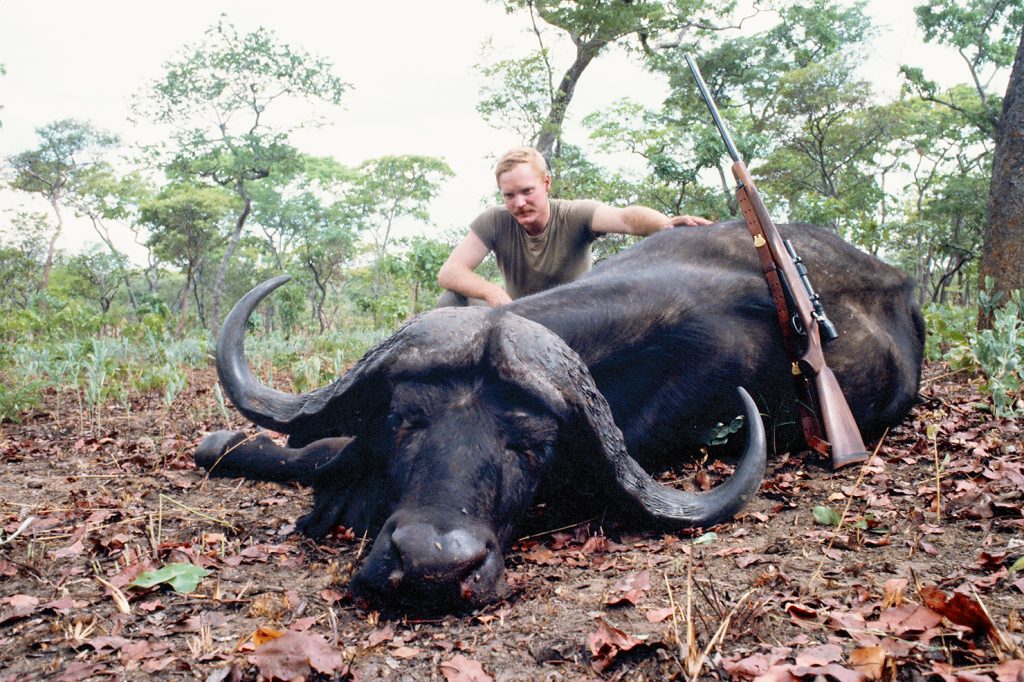
The .375 H&H is not the only shootable .375. The .375 Winchester, introduced in 1978, is a potent cartridge, with performance like the old 9.5×57 Mannlicher and .400/.375. All three of these were effective short-range cartridges for medium game, lacking in power for larger stuff. All three are pretty much dead.
Recent .375 cartridges include the .376 Steyr (1999), and .375 Ruger (2007). The .376 Steyr was developed to fit Jeff Cooper’s “Super Scout Rifle” concept: Short and light, with a forward-mounted scope, yet capable of handling larger game. I’m not much on the scout rifle thing, but the .376 Steyr is a capable cartridge, shooting a 270-grain bullet up to 2,600 fps, producing 4,000 ft-lbs of energy. It has less recoil than the .375 H&H, yet still legal worldwide for the largest game. My wife, Donna, has one built by MGA on a Remington action in Cerakote and synthetic, and it’s a great rifle. Last time we were in Mozambique, she took it to the swamp and dropped a good buffalo with one shot.
The only thing about the .376 Steyr: It is not popular. Ammo is scarce, and its case is based on the 9.3×64 Brenneke, which is rare in the US. The idea was a lighter rifle for Donna, yet with less recoil than a too-light .375 H&H. MGA’s Kerry O’Day suggested building her a 9.3×62. I insisted on the .376 Steyr. We are happy with the .376 Steyr and we have plenty of ammo, but I concede he was right.
Available worldwide, the H&H is the most popular .375 cartridge. The Hornady-designed .375 Ruger is a not-so-distant second. We first saw it while filming Tracks Across Africa in 2006 and spilled the beans prematurely, resulting in an a shockingly successful release. Since then, sales have cooled but remain steady. Based on a brilliantly simple new case, the .375 Ruger uses the .532-inch rim and base diameter of a belted magnum—without the belt—thus increasing case capacity while using standard belted magnum bolt face and magazine. Case length is 2.580 inches, housed in a .30-06-length action. The H&H’s 2.85-inch case requires a full-length action.
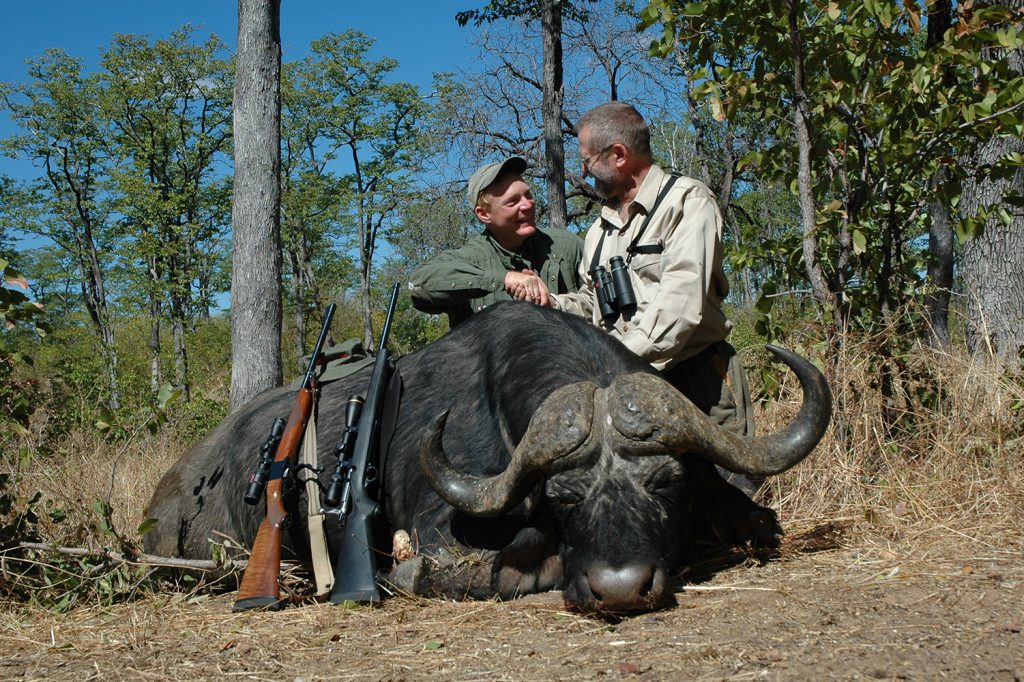
The .375 Ruger has found favor with manufacturers who don’t make .375-length actions. In platforms such as the Savage 110, Mossberg Patriot, and Ruger Hawkeye, the .375 Ruger is now the world’s most available and affordable dangerous-game rifle. I used a Mossberg Patriot in stainless and laminate on my polar bear hunt, and it was perfect for the Arctic. Just a month ago I was in a spike camp for brown bears on the Alaska Peninsula. There were two hunters, two guides, and a packer, with five rifles between us. Three were Ruger Hawkeyes in .375 Ruger, plus a Gunwerks in .375 Ruger. I was the lone holdout; I carried a .338 Winchester Magnum.
The .375 Ruger’s modern, unbelted case fits in a shorter, lighter action with shorter bolt throw than the .375 H&H. Absent body taper, despite its shorter case it offers 4 percent greater case capacity than the H&H. Add the efficiency of the shorter, fatter case, and the .375 Ruger exceeds the .375 H&H by about 150 fps, obviously delivering more energy. This is not enough of an increase to create excessive recoil, nor put it in a different power class. However, be careful with a .375 Ruger: You don’t want it in too light a rifle!
The choice today depends largely on the rifle platform you prefer. Since 2007 I’ve used both. There’s nothing the H&H will do that a .375 Ruger can’t do, and vice versa. Being a bit of a nostalgia freak, I suppose I prefer the .375 H&H. I doubt the .375 Ruger will become more popular than the H&H, nor offered in as many loadings from as many sources. But I concede that, in all the ways I can think of, the .375 Ruger is a better cartridge.
